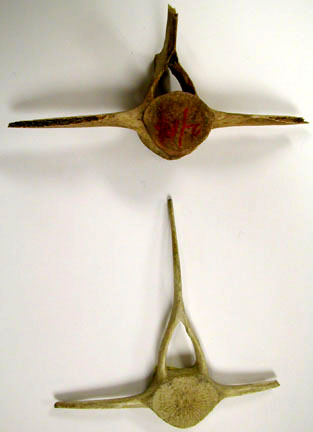

With all good wishes,
Simon Moore, MIScT, FLS,
ACR,
Senior Conservator of
Natural Sciences.
Hampshire
County Council,
Department
of Culture, Communities and Rural Affairs,
Museums & Archives Service,
Chilcomb House, Chilcomb
Lane,
Winchester SO23 8RD.
UK.
Internal 8 327
6737
01962
826737
http://www.hants.gov.uk/museum/biology


Claire Sturman
Natural
Science Officer
-----Original Message-----
From: The Natural Science Collections Association discussion list [mailto:[log in to unmask]]On Behalf Of Moore, Simon
Sent: 04 September 2009 10:06
To: [log in to unmask]
Subject: Re: bone identificationYes, I would agree with Peter; the gap looks like part of a neural arch.With all good wishes,
Simon Moore, MIScT, FLS, ACR,
Senior Conservator of Natural Sciences.
Hampshire County Council,
Department of Culture, Communities and Rural Affairs,
Museums & Archives Service,
Chilcomb House, Chilcomb Lane,
Winchester SO23 8RD. UK.
Internal 8 327 6737
01962 826737
http://www.hants.gov.uk/museum/biology
From: The Natural Science Collections Association discussion list [mailto:[log in to unmask]] On Behalf Of Peter Howlett
Sent: 03 September 2009 10:36
To: [log in to unmask]
Subject: Re: bone identificationHi ClaireLooks like a heavily sea-worn vertebra to me. The round articular facet and its size might suggest a cetacean such as Bottlenose Dolphin, although I stand to be corrected on that.Peter HowlettDept of BioSyB
Amgueddfa Cymru - National Museum Wales
Cathays Park
Cardiff
CF10 3NP
Tel: +44 (0)29 2057 3233
Back the bid!
Help bring the World Cup in 2018 to Portsmouth - visit www.portsmouth.gov.uk/backthebid today to register your support.
*****************************************************
This email is for the intended recipient(s) only.
If you have received this email due to an error in addressing, transmission or for any other reason, please reply to it and let the author know. If you are not the intended recipient, you must not use, disclose, distribute, copy or print it.
This email may be monitored, read, recorded and/or kept by Portsmouth City Council. Email monitoring and blocking software may be used.
*****************************************************